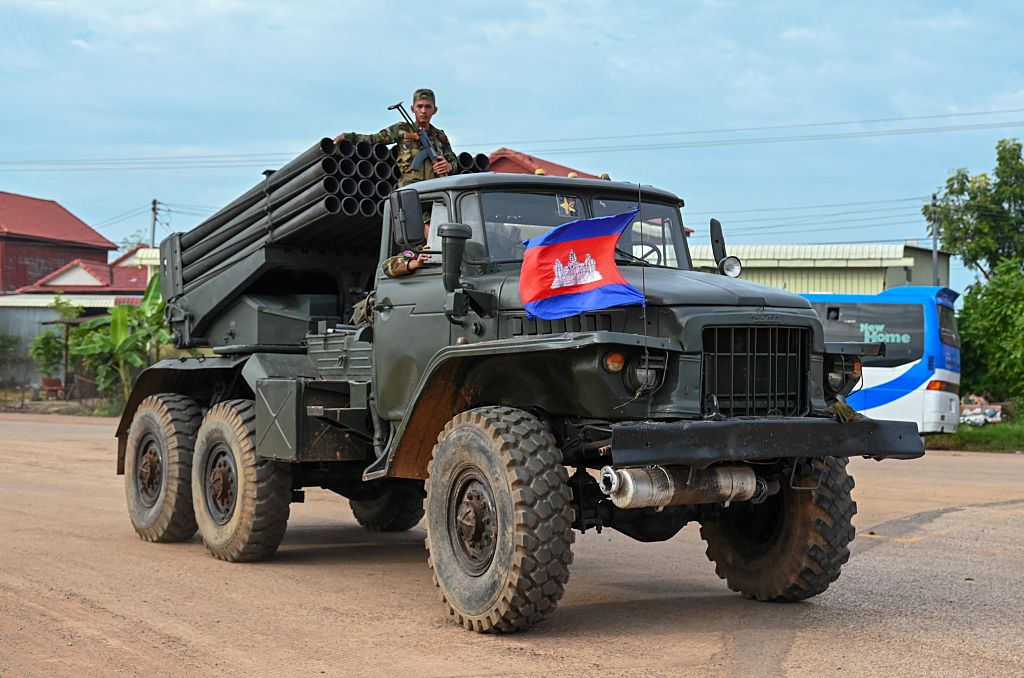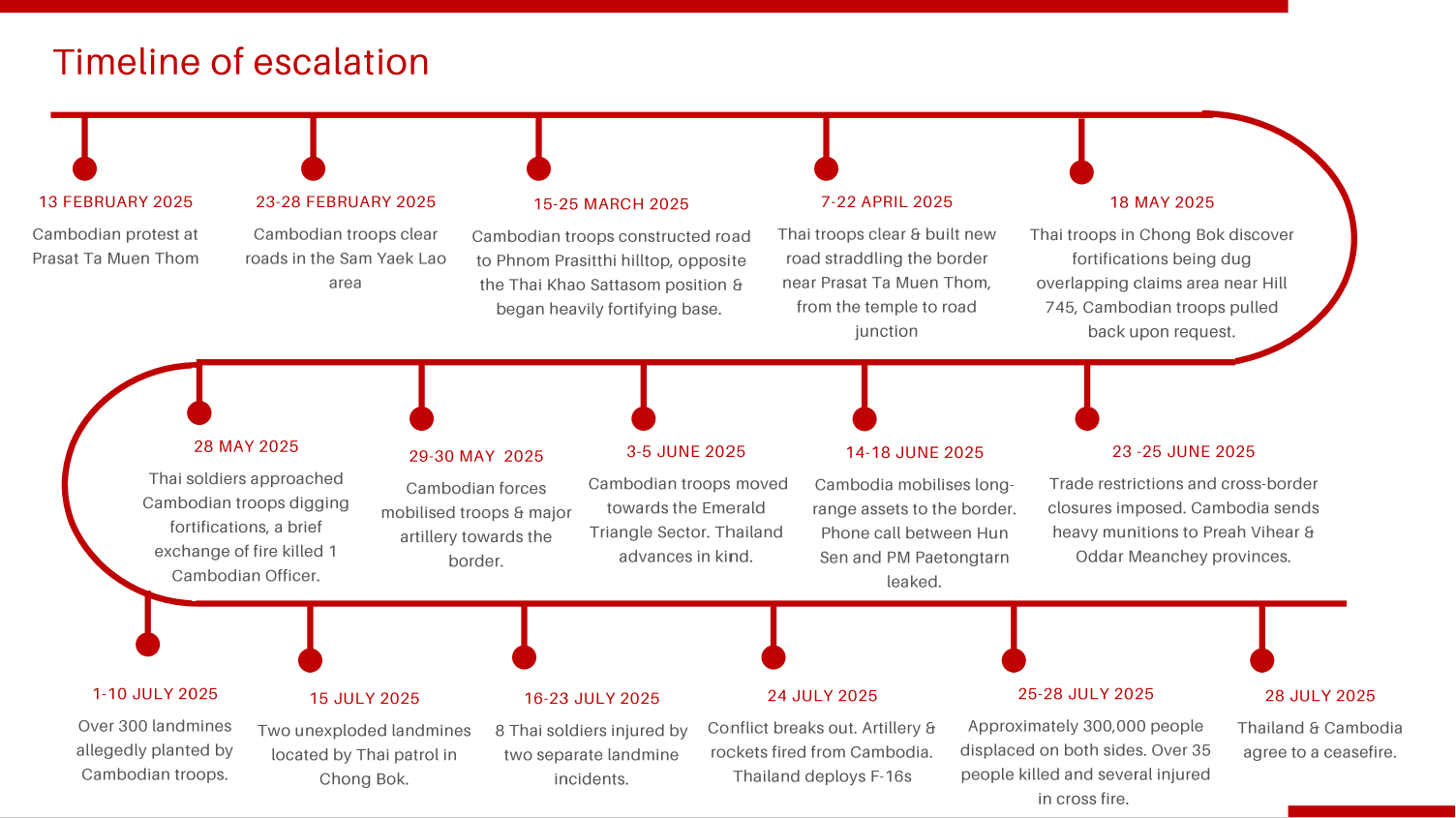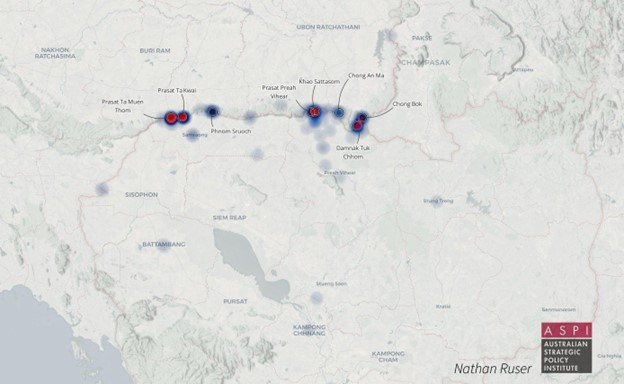
The eruption of fighting between Thailand and Cambodia on 24 July may appear to have been sudden, but it was neither abrupt nor unforeseen. It was the product of a calculated build-up and was shaped as much by domestic politics and legacy ambitions as by maps and military strategy.
On 28 July, the two countries agreed to a ceasefire, with breaches reported on 29 July.
Throughout late 2024, Cambodia had been quietly upgrading access routes near disputed or strategically important border areas. In improving access, Cambodia was repeating its earlier tactics of shifting facts on the ground under the pretence of civilian or infrastructure development.
At the heart of the escalation are two entrenched political dynasties, Thailand’s Shinawatras and Cambodia’s Hun family. Once bound by personal and economic ties, the relationship has since fractured, with both parties using the border standoff to consolidate power and project strength.
While a Cambodian protest in February at Prasat Ta Muen Thom is often cited as the spark of recent tensions, signs of escalation appeared months earlier. Military posturing has intensified on both sides, with Thai intelligence reportedly flagging increased Cambodian troop activity near Chong Bok, suggesting the confrontation may be not merely reactive but part of a longer-term strategy.
Data collected by ASPI analysts based on open-source intelligence identified 33 escalatory events attributed to Cambodia, compared with 14 attributed to Thailand, alongside nine joint de-escalatory efforts. While this article tracks military mobilisation on both sides, the limited availability of Cambodian reporting has restricted a comprehensive assessment of the conflict’s full dynamics.

Source: authors.
Critical infrastructure development
While Cambodia has been actively framing the transformation of Preah Vihear province—a border province home to the Preah Vihear temple, the subject of longstanding disputes—as economic revival through infrastructure, field observations suggest a dual-purpose shift. Roadworks within or adjacent to Preah Vihear and troop movements near key areas coincide with major road upgrades—linking Phnom Penh to border flashpoints once considered remote. The locations that have been improved in recent years are directly tied to military positioning and strategic hilltops or access routes and drastically expand fortified Cambodian positions atop the plateau. These positions allow the Cambodian army to operate on level ground and, in some cases, from above the Thai army—a drastic tactical shift along much of the border.
Satellite observations between March and May revealed pre-positioning activity, a potential signal of logistical reinforcement. While Thailand did not respond militarily at this stage, Cambodia became more assertive. By the end of March, Cambodian troops stepped up clearing and developing access routes from the Sam Yaek Lao area, a key access corridor towards the Phnom Praset Thisou hilltop, which is located directly opposite Thailand’s Khao Sattahsom position. The Phnom Praset Thisou site was rapidly fortified, suggesting Cambodian preparations for sustained occupation or a defensive posture. Simultaneously, Cambodian forces began establishing new positions in the Chong Bok area, indicating a broader push to consolidate territorial control.
In April, Thailand had begun to shore up its tactical position along the frontline as well, building a new road along the hotly contested Prasat Ta Muen Thom frontline. These actions—including Cambodian fortification at Chong Bok, where a Cambodian officer was killed in May—marked a shift from temporary patrols to long-term entrenchment on both sides.

A heatmap of Cambodian military activity between 28 May to 24 July. Source: Nathan Ruser/ASPI.
Military posturing
What followed was Cambodia’s mobilisation of troops and heavy weapons towards the Emerald Triangle, the tri-border junction between Cambodia, Thailand and Laos that has held strategic importance due to its remoteness, forest cover and use in historical insurgencies. BM-21 rocket artillery, SH-1 self-propelled guns and nearly 30 Soviet-era T-55 tanks rolled into place, according to official reports seen by the authors.
Diplomatic efforts to ease tensions backfired after a leaked phone call between Thai Prime Minister Paetongtarn Shinawatra and former Cambodian leader Hun Sen sparked outrage in Thailand that led to Paetongtarn’s suspension as prime minister.
Meanwhile, Cambodian forces dug trenches up to 300 metres into territory claimed by Thailand at Damnak Tuk Chom outpost. Relations worsened with both sides closing border crossings and halting imports. By late June, Cambodia had transferred significant ammunitions, including over 500 BM-21 rockets, to frontline positions.
Tensions peaked in July after two landmine incidents severely injured Thai soldiers, some requiring amputations. Cambodia denied responsibility and attributed the blasts to unexploded mines from past conflicts, but Thai sources argue that the uncovered PMN-2 mines were distinct from old munitions of the 1990s and were found in previously cleared patrol zones. The incident led Bangkok to recall its ambassador and downgrade diplomatic ties.
Fighting broke out on the morning of 24 July when Cambodian forces allegedly opened fire, followed by artillery strikes that hit Thai positions and civilian areas. BM-21 rockets are imprecise weapons. Yet they were launched into populated zones, killing civilians and damaging infrastructure, including schools and hospitals, according to Thai authorities. Thailand responded with airstrikes using F-16s to target Cambodia’s military units and secure the eastern front.
Why now? Legacy and domestic politics
Much attention has focused on Cambodia’s assertive military posture, especially given its military disadvantage. Why, then, would Phnom Penh allow tensions to reach this point? One explanation lies in timing. Thailand’s political instability and the Shinawatra faction’s return to power may have seemed like a strategic opening for Hun Sen’s camp to push territorial claims more forcefully.
Economic frictions also added pressure. Thailand’s crackdowns on scam centres, timber smuggling, along with uncertainty around its casino legalisation—which threatens a revenue stream for Cambodian elites—may have further strained relations. Hun Sen might have seen 2025 as a year in which conditions allowed for limited coercion without full-scale military fallout.
The escalation could also be an effort to paint his son and successor, Prime Minister Hun Manet, as a wartime leader and to deflect from domestic challenges. But it’s Hun Sen who has been the visible orchestrator of the campaign—directing troop movements, issuing threats and leaking the call with Paetongtarn. This was a show of strength at the border—one tied to symbols of Cambodian heritage which served to reinforce legitimacy and consolidate public support.
The leaked audio, in which Paetongtarn endearingly refers to Hun Sen as ‘uncle’ and the Thai military officials as ‘the opposite side’, triggered a domestic uproar in Thailand and cast doubt over her ability to lead a security crisis. Phumtham Wechayachai has since taken charge as acting prime minister, amid criticism that the government was slow to counter Cambodia’s narrative.
Adding to the chaos, the Shinawatra patriarch and former longtime friend of Hun Sen, Thaksin Shinawatra, posted what appeared to be Thai military directives, highlighting the surreal state of Thai politics. With Thai politics adrift and the Shinawatra camp weakened, Hun Sen’s provocations achieved short-term political disruption in Bangkok. But it remains unclear what strategic gain Cambodia earns from rocket attacks and international backlash.
Civilian impact and the path forward
Civilians have borne the brunt of the escalation. About 300,000 people have been displaced, at least 35 killed and many more injured on both sides. Military actions may aim to show resolve but, once civilians are harmed, public opinion hardens and the space for negotiation narrows. Thailand must tread carefully: its military edge is clear, but further escalation risks a humanitarian crisis.
While the conflict may seem like nationalist posturing, it is also fuelled by deeper forces—including economic strain, political transitions and longstanding fears of territorial loss—that shape each side’s strategic calculus. These dynamics have created a volatile environment where trust is low, compromise is elusive and escalation is more likely.
Despite the ceasefire agreement, there are already reported breaches. The focus must shift to sustaining dialogue. Both countries share a border, a history and intertwined economies. Their futures, whether war-torn or peaceful, are inextricable. Peace is not a concession here; it is a responsibility. True leadership lies in stepping back from conflict to safeguard civilians and secure a stable, shared future.